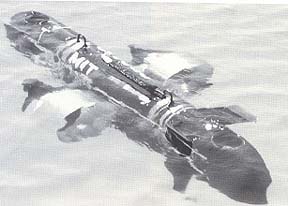
|
Archives:
Fall 1999 Table
of Contents
Ara Knaian and some 15 fellow MIT students spent much of last summer sitting around his uncle’s swimming pool. But slackers they’re not. Decked out with laptops and furiously writing code for Orca-2, the small, autonomous underwater vehicle they developed, the students were preparing for the Second International Autonomous Underwater Vehicle (AUV) Competition. That preparation paid off, landing the team first place for the second year running. Drawing
on what they’d learned from the original Orca, the MIT
students refined their vehicle for the 1999 competition, held in
Panama City, Florida, and sponsored by The Association for Unmanned
Vehicle Systems International and the Office of Naval Research.
"The big difference between this year and last year is that
we had learned the importance of design," says Knaian, who
received his M.S. in electrical engineering this past spring from
MIT and will receive his Masters in electrical engineering in 2000.
He adds: "It’s a lot easier to change something on paper
than in reality." But designing and building an underwater vehicle is only part of the International AUV competition, open to students at all universities. The real test is navigating the vehicle along a submerged obstacle course in a Florida test pond known as P-253. Operating autonomously under computer control, vehicles must pass through a series of gates submerged along the perimeter of the pond, then enter a specified recovery zone, drop a marker, and surface, all within 20 minutes. In the 1998 competition, the MIT vehicle went through two gates before beaching itself–an effort still strong enough to beat out the other teams. This year Orca-2 successfully navigated through all six gates to defeat teams from the University of Florida, Florida Atlantic University, the U.S. Naval Academy and Stevens Institute of Technology and bring home a $5,000 prize. Knaian notes that all the teams had improved significantly and he expects both next year’s course and competition will be fiercer. While Orca-2 can’t compete with the likes of MIT Sea Grant’s more powerful Odyssey vehicles right now, its designers show unlimited promise. John Leonard, an assistant professor in MIT’s Department of Ocean Engineering, was the students’ advisor on the project, but states that his role was minimal. "Their achievement is amazing, and they really did it all themselves," he says, emphasizing the speed with which the students worked. And the project had no shortage of MIT sponsors, including MIT Sea Grant, the Department of Ocean Engineering, the Media Lab, the Department of Earth Atmospheric and Planetary Sciences, the Center for Global Change Science, and the President’s Office. Already the students are looking forward to taking Orca-2 to the next level. "We’re excited about next year’s vehicle," says Knaian. "We have the platform. People can write code for it, do demos, and add capabilities." This year’s prize money will help finance those efforts. And while the family pool may be closed for the summer, MIT’s indoor chlorine drink is available through the snowiest winter. For more information, see http://orca2.mit.edu/
|
